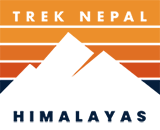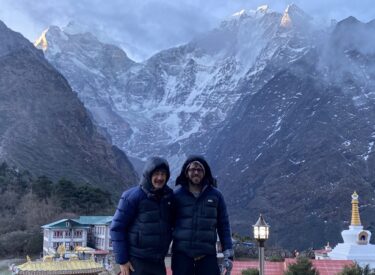Ama Dablam Base Camp Trekking
based on 152 reviews
Overview of Ama Dablam Base Camp Trekking
Ama Dablam Base Camp Trekking is a popular trekking route in the Everest region of Nepal, which takes you to the base of the beautiful Ama Dablam mountain and offers stunning views of the Himalayas. The trek is known for its beautiful mountain scenery and the opportunity to experience the culture and traditions of the Sherpa people.
Highlights of Ama Dablam Base Camp Trekking
- Journey Begins in Lukla: The Ama Dablam Base Camp Trekking starts with an exhilarating flight from Kathmandu to Lukla, setting the stage for an unforgettable adventure.
- Trek Along Dudh Koshi River: As part of the Ama Dablam Base Camp Trekking, you’ll follow the mesmerizing Dudh Koshi River, surrounded by stunning natural beauty.
- Namche Bazaar and Sagarmatha National Park: The Ama Dablam Base Camp Trekking takes you through the bustling Namche Bazaar and the biodiverse Sagarmatha National Park.
- Explore Buddhist Heritage: A unique aspect of the Ama Dablam Base Camp Trekking is visiting sacred Buddhist sites, including the revered Tengboche Monastery.
- Stunning Views at Base Camp: Reaching the Ama Dablam Base Camp at 4,800 meters, you are rewarded with breathtaking vistas of the Himalayan giants.
- Sherpa Cultural Experience: The Ama Dablam Base Camp Trekking offers a deep dive into the rich culture and traditions of the Sherpa community.
- Best Seasons for Trekking: Ideal for Ama Dablam Base Camp Trekking, the months from September to November and March to May offer clear skies and pleasant weather.
Itinerary of Ama Dablam Base Camp Trekking
A scenic 40-minute flight from Kathmandu takes you to Lukla. In Lukla, meet the remaining crews then start trekking to Phakding. It is 3 3-hour gentle walk through the banks of Dudh Koshi River to Phakding. Overnight at Phakding.
After breakfast, we follow the Dudhkoshi River. We then pass several suspension bridges. After 6.5 hours of walking, we reached Namche Bazar, which is the trading centre of Khumbu Region. Overnight.
A rest day in Namche Bazar. On this day, we visit the Tourist Visit Center to collect knowledge of Sherpa traditions, cultures, flora and fauna of the Khumbu Region. We also can hike up to Thame. As Namche is the last place to check the gears, we also have time to review our gears, and if something is missed, we can hire it there. Overnight.
On this day, the trail goes up and down, and magnificent views of Mt Everest, Mt Nuptse, Mt Lhotse and close views of Thamserkhu and Amadablam will accompany you to Tengboche. As Tengboche is one of the best Mountain Viewpoints, we can enjoy the superb views of the mountains. Tengboche also has the most prominent Buddhist Monastery in the Everest Region. Enjoy exploring. Overnight.
Early morning we will have our breakfast, after then we will resume our trekking. This day we will be trekking for three to four hours when we can enjoy stunning views of Amadablam along the way. In Pangboche, we will get chance to explore the oldest Buddhist monastery of Everest region. Overnight at hotel.
A long trekking day when we will get to our ultimate goal. After early morning breakfast we start our trekking from Pangboche to Amadablam Base Camp which takes three/four hours trekking. In base camp, we will enjoy the 360 panoramic views of mighty Himalayas. After spending some wonderful moments in Base Camp, we will then trek back to Pangboche for overnight. Overnight at Pangboche.
Our trail from Pangboche descends through dense forest, where we can see some musk deer. It takes us seven to eight hours to reach incredible Khumjung Village from Pangboche where we will stay overnight.
Today, you will first descend to Namche Bazar and continues to descent down to national park check point Monju. From Monju we further trek through dense forest and then follow the west bank of Dudh Koshi river to Phakding.
With 3-4 hours descend trail trek from Phakding we will reach to Lukla. In the evening there will be a farewell dinner with Sherpa and Guides. Overnight at Lukla.
We take an early morning flight to get back to Kathmandu from Lukla. In free time, we can explore around Thamel to do some last minutes shopping. In the evening, join a farewell dinner organized by Trek Nepal Himalayas.
Added Insights
Includes/Excludes
What's Included?
- Two times airport pick and drop off by a private vehicle
- Domestic flight tickets (Kathmandu to Lukla and Lukla to Kathmandu) including airport taxes. If airlines change flight destination to Ramechap to Lukla and Lukla to Ramechap- then transportation is included too.
- Tea house accommodation during the trekking as per itinerary. (The rooms will be in twin sharing basis and will not have an attached bathroom). If you want to upgrade, then let us know at the time of booking. (Still no attached rooms available in Lobuche and Gorakshep. Likewise, limited options in Tengboche too).
- Meals during the trekking (3 meals a day)
- Government licensed English-speaking trek leader. 1:8 ratio.
- Assistant guide(s) if there are more than 8 trekkers in a group (1:9 ratio).
- Porter to help trekkers luggage. 2 trekkers will share 1 porter, Max weight limit for a porter- 20 kg (10 kg per trekker, weight limit). You can store non-essential items in Kathmandu hotel for free.
- Guide(s), assistant guide(s) and porter (s) wages, their meals, insurance, lodging, transportation, flight, and other necessary equipment as well.
- Sagarmatha National Park Entrance Fee.
- Khumbu Pasang Lhamu Rural Municipality entry permit fees
- Fresh (seasonal fruits)- every evening after dinner.
- Assistance in arranging rescue operations in case of complicated health conditions (funded by travel insurance)
- Trek completion Certificate after the successful trekking
- All government taxes and fees
What's Excluded?
- International flight costs
- Nepal Entry Visa Fees for multiple entries on arrival at Tribhuvan International Airport- (more at: https://treknepalhimalayas.com/nepal-visa-information/)
- Excess baggage charges (Limit is 10 kg per Person) on the trek
- Food and accommodation in Kathmandu.
- Extra night accommodation in Kathmandu due to early arrival, late departure, or early return from the trek.
- Personal expenses (shopping, snacks, boiled bottled water, hot (Tea/ Coffee) and cold drinks, hot shower, alcohol, Wi-Fi, telephone call, battery recharge fee, extra porters, etc.) during the trekking.
- Travel insurance that covers emergency high-altitude rescue and evacuation (recommended)
- Tipping (Guide, assistant guide, porter)
- Any additional costs incurred beyond our control, like landslides, weather, itinerary modifications due to safety concerns, illness, change of government policies, strikes, etc.
- Anything is not mentioned in the inclusion list.
Essential Information - Ama Dablam Base Camp Trekking
The Ama Dablam Base Camp Trekking usually begins in Lukla, which a short flight from Kathmandu can reach. From there, you will follow the Dudh Koshi River, passing through the village of Namche Bazaar and the Sagarmatha National Park. You will then continue to the Ama Dablam Base Camp, passing through the villages. Along the way, you will visit several Buddhist monasteries and temples, including the Tengboche Monastery.
This Ama Dablam Base Camp Trekking is a moderate to challenging trek, with a total distance of about 120 kilometres (75 miles). The walk can take anywhere from 8 to 12 days, depending on your pace and available days. The highest point on the trek is the Ama Dablam Base Camp, which stands at an elevation of 4,800 meters (15,744 feet). From here, you will have breathtaking views of Ama Dablam and the surrounding peaks, including Lhotse, Nuptse, and Makalu.
The Ama Dablam Base Camp Trekking offers a unique way to experience the natural beauty of the Himalayas and the rich culture and traditions of the Sherpa people. It is a challenging trek that requires good physical fitness, but the rewards of the stunning mountain views and the cultural insights are worthwhile. The best months to do the Ama Dablam Base Camp Trek are September to November and March to May when the weather is clear and dry.
Trek to New Heights: Explore the Majestic Ama Dablam in the Himalayas
Nestled in the eastern Himalayas of Nepal, the majestic Ama Dablam stands tall, with its prominent peak reaching a height of 6,812 meters and its lower western peak at 6,170 meters. It is affectionately known as the “Mother’s necklace” due to its long ridges resembling a mother’s arms and the hanging glacier symbolizing a traditional double-pendant worn by Sherpa women. Its soaring ridges and steep faces have earned it the nickname of the “Matterhorn of the Himalayas.” In 1961, a team of climbers successfully scaled Ama Dablam, and today, it is the third most sought-after peak for permitted expeditions, with the Southwest Ridge being the most popular route
Discover the Beauty of Ama Dablam: Ama Dablam Base Camp Trekking
- The Ama Dablam Base Camp Trekking is famous in the Everest region of Nepal.
- It takes you to the base of the beautiful Ama Dablam mountain and offers stunning views of the Himalayas.
- Trek begins in Lukla, reachable by a short flight from Kathmandu
- Follows the Dudh Koshi River, passing through Namche Bazaar, Sagarmatha National Park, and several Buddhist monasteries and temples
- A moderate to challenging trek with a total distance of 120 km (75 miles), taking 8 to 12 days depending on the pace
- The highest point on the Ama Dablam Base Camp Trekking, standing at an elevation of 4,800 meters (15,744 feet)
- It provides a unique experience of the natural beauty of the Himalayas and the rich culture and traditions of the Sherpa people
- Requires a good level of physical fitness, but with stunning mountain views and cultural insights as rewards
- The best months for the trek are September to November and March to May for clear and dry weather.
Trek to Ama Dablam Base Camp Trekking: The Ideal Seasons and Weather Conditions for a Safe and Enjoyable Journey
The best seasons for trekking to Ama Dablam Base Camp Trekking are the spring (March to May) and the autumn (September to November). The weather is generally clear and stable during these seasons, offering clear views of the surrounding mountains and landscapes. The temperature is also mild, making it more comfortable for trekking.
The monsoon season (June to August) is generally not recommended for trekking as the region experiences heavy rainfall, making the trails slippery and increasing the risk of landslides. The winter months (December to February) can be freezing and snow-covered, making the Ama Dablam Base Camp Trekking difficult and, at times, impassable.
| Season | Description | Weather | Temperature | Trekking Conditions |
|---|---|---|---|---|
| Spring (March to May) | Best season for trekking | Clear and stable | Mild | Comfortable |
| Autumn (September to November) | Best season for trekking | Clear and stable | Mild | Comfortable |
| Monsoon (June to August) | Not recommended for trekking | Heavy rainfall | Warm | Slippery trails, increased risk of landslides |
| Winter (December to February) | Difficult for trekking | Extremely cold and snow-covered | Cold | Difficult, impassable at times |
Reviews on Ama Dablam Base Camp Trekking
Be first to post a review in this trip.






